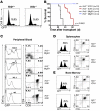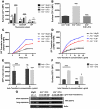HIV-1 Rev-binding protein accelerates cellular uptake of iron to drive Notch-induced T cell leukemogenesis in mice
- PMID: 20516639
- PMCID: PMC2898592
- DOI: 10.1172/JCI41277
HIV-1 Rev-binding protein accelerates cellular uptake of iron to drive Notch-induced T cell leukemogenesis in mice
Abstract
Somatic activating mutations in Notch1 contribute to the pathogenesis of T cell acute lymphoblastic lymphoma (T-ALL), but how activated Notch1 signaling exerts this oncogenic effect is not completely understood. Here we identify HIV-1 Rev-binding protein (Hrb), a component of the clathrin-mediated endocytosis machinery, as a critical mediator of Notch-induced T-ALL development in mice. Hrb was found to be a direct transcriptional target of Notch1, and Hrb loss reduced the incidence or delayed the onset of T-ALL in mouse models in which activated Notch1 signaling either contributes to or drives leukemogenesis. Consistent with this observation, Hrb supported survival and proliferation of hematopoietic and T cell precursor cells in vitro. We demonstrated that Hrb accelerated the uptake of transferrin, which was required for upregulation of the T cell protooncogene p21. Indeed, iron-deficient mice developed Notch1-induced T-ALL substantially more slowly than control mice, further supporting a critical role for iron uptake during leukemogenesis. Taken together, these results reveal that Hrb is a critical Notch target gene that mediates lymphoblast transformation and disease progression via its ability to satisfy the enhanced demands of transformed lymphoblasts for iron. Further, our data suggest that Hrb may be targeted to improve current treatment or design novel therapies for human T-ALL patients.
Figures









Similar articles
-
Notch dimerization is required for leukemogenesis and T-cell development.Genes Dev. 2010 Nov 1;24(21):2395-407. doi: 10.1101/gad.1975210. Epub 2010 Oct 8. Genes Dev. 2010. PMID: 20935071 Free PMC article.
-
MAFB enhances oncogenic Notch signaling in T cell acute lymphoblastic leukemia.Sci Signal. 2017 Nov 14;10(505):eaam6846. doi: 10.1126/scisignal.aam6846. Sci Signal. 2017. PMID: 29138297 Free PMC article.
-
NOTCH1 dimeric signaling is essential for T-cell leukemogenesis and leukemia maintenance.Blood. 2025 Jun 12;145(24):2887-2902. doi: 10.1182/blood.2024027020. Blood. 2025. PMID: 40009499
-
New insights into Notch1 regulation of the PI3K-AKT-mTOR1 signaling axis: targeted therapy of γ-secretase inhibitor resistant T-cell acute lymphoblastic leukemia.Cell Signal. 2014 Jan;26(1):149-61. doi: 10.1016/j.cellsig.2013.09.021. Epub 2013 Oct 16. Cell Signal. 2014. PMID: 24140475 Review.
-
T cell acute lymphoblastic leukemia/lymphoma: a human cancer commonly associated with aberrant NOTCH1 signaling.Curr Opin Hematol. 2004 Nov;11(6):426-33. doi: 10.1097/01.moh.0000143965.90813.70. Curr Opin Hematol. 2004. PMID: 15548998 Review.
Cited by
-
Characterization and identification of PARM-1 as a new potential oncogene.Mol Cancer. 2013 Jul 31;12:84. doi: 10.1186/1476-4598-12-84. Mol Cancer. 2013. PMID: 23902727 Free PMC article.
-
Human immunodeficiency virus rev-binding protein is essential for influenza a virus replication and promotes genome trafficking in late-stage infection.J Virol. 2011 Sep;85(18):9588-98. doi: 10.1128/JVI.05064-11. Epub 2011 Jul 13. J Virol. 2011. PMID: 21752912 Free PMC article.
-
Evolutionary distance of amino acid sequence orthologs across macaque subspecies: identifying candidate genes for SIV resistance in Chinese rhesus macaques.PLoS One. 2015 Apr 17;10(4):e0123624. doi: 10.1371/journal.pone.0123624. eCollection 2015. PLoS One. 2015. PMID: 25884674 Free PMC article.
-
Chemotherapy-induced cellular senescence suppresses progression of Notch-driven T-ALL.PLoS One. 2019 Oct 29;14(10):e0224172. doi: 10.1371/journal.pone.0224172. eCollection 2019. PLoS One. 2019. PMID: 31661505 Free PMC article.
-
Altered trafficking of mutated growth factor receptors and their associated molecules: implication for human cancers.Cell Logist. 2014 Mar 18;4:e28461. doi: 10.4161/cl.28461. eCollection 2014. Cell Logist. 2014. PMID: 25210647 Free PMC article.
References
Publication types
MeSH terms
Substances
Grants and funding
LinkOut - more resources
Full Text Sources
Molecular Biology Databases

